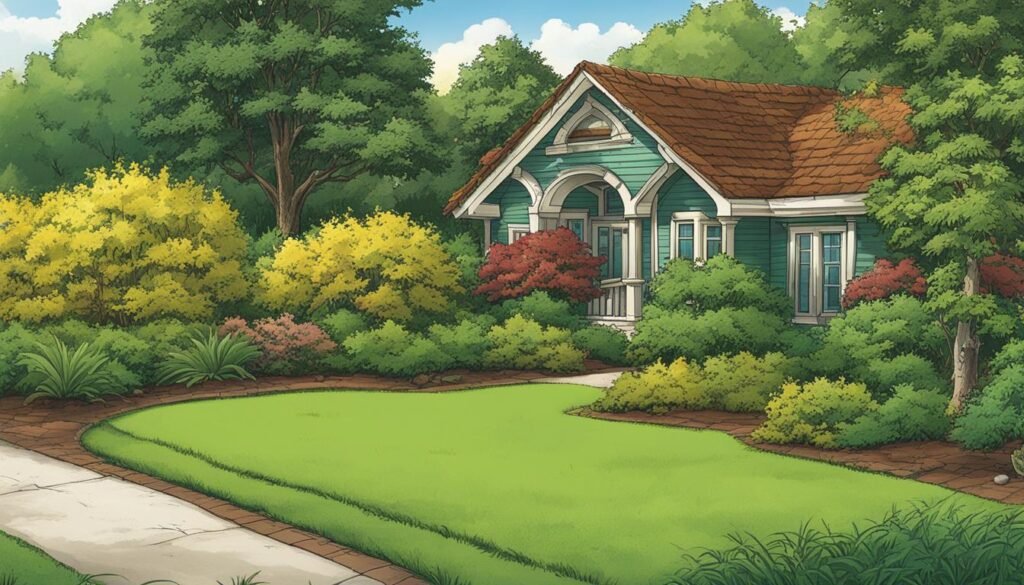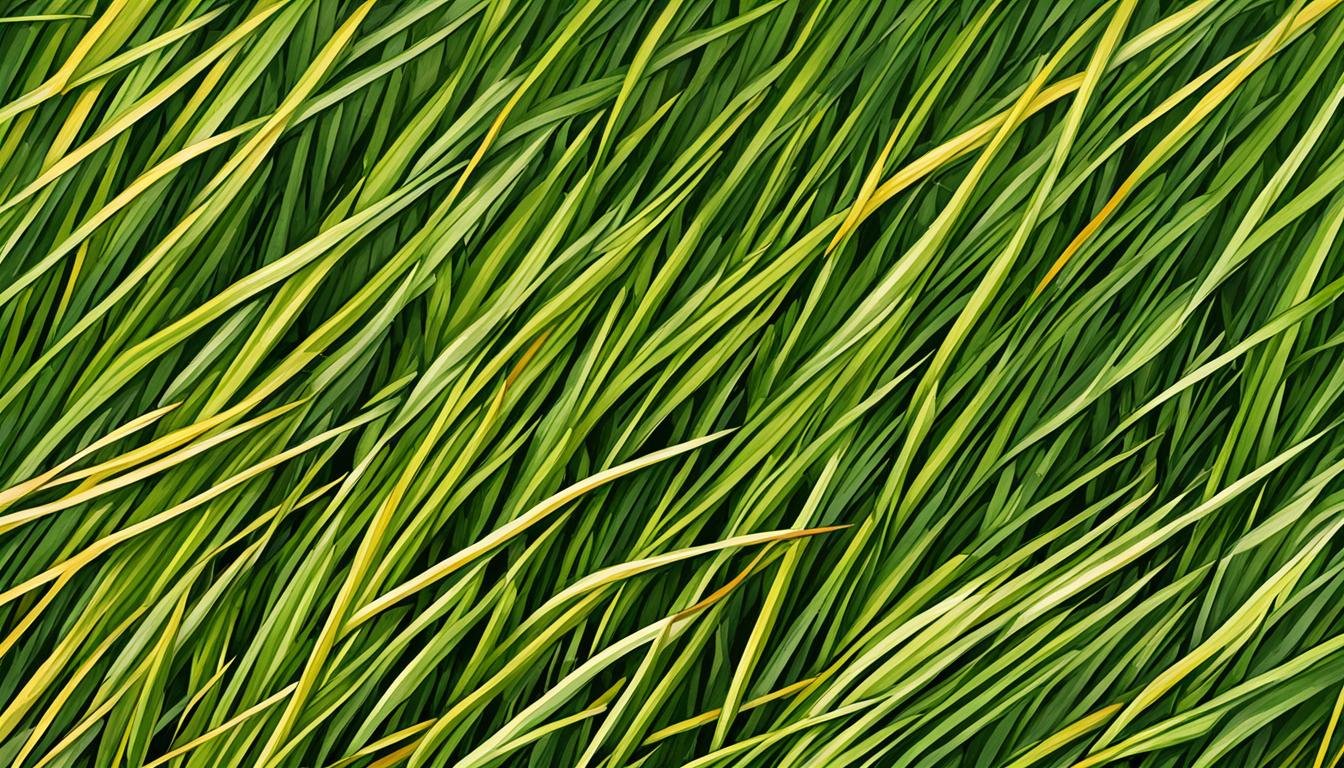If you’ve noticed your St. Augustine grass taking on a yellow hue, you may be wondering what’s causing this issue. Yellowing of St. Augustine grass is a common concern among homeowners, but the good news is that it can be addressed. In this article, we’ll explore the possible causes of yellowing in St. Augustine grass and provide solutions to help you restore its vibrant green color.
Key Takeaways:
- Nutrient deficiencies, like a lack of nitrogen and iron, can lead to yellowing of St. Augustine grass.
- Soil temperature, pH levels, and compaction can also contribute to the problem.
- Fungal infections, such as Rhizoctonia solani and Take All Root Rot, can cause patches of yellow or brown grass.
- To address yellowing, focus on improving soil health, addressing nutrient deficiencies, and treating any fungal infections.
- Regular lawn care practices, such as proper mowing and watering, are essential in maintaining a healthy St. Augustine grass lawn.
Nutrient Deficiencies and Chlorosis in St. Augustine Grass
Nutrient deficiencies can be a major factor contributing to the yellowing of St. Augustine grass. Specifically, a lack of nitrogen and iron can lead to chlorosis, a condition characterized by the loss of chlorophyll and the yellowing of the grass. When the soil temperatures and pH levels are too high, the grass is unable to effectively absorb these crucial nutrients, resulting in a decline in its vibrant green color.
To address this issue and restore the health of your St. Augustine grass, it is essential to focus on improving the soil’s nutrient content. Adding organic matter to the soil can enhance its overall health and promote better nutrient uptake. You can also consider applying liquid seaweed with added iron or using a chelated iron spray, both of which can help replenish the deficient nutrients and restore the grass’s green color.
Additionally, it’s important to address any underlying factors that may contribute to nutrient deficiencies in the soil. Soil compaction and poor soil health can further hinder nutrient absorption, exacerbating the yellowing of the grass. Aeration, which involves creating small holes in the soil, can help alleviate compaction and stimulate microbial activity, allowing for better nutrient availability to the grass roots.

Fungal Infections and Yellowing in St. Augustine Grass
Fungal infections can be a significant cause of yellowing in St. Augustine grass. One common culprit is Rhizoctonia solani, a fungus that can lead to the development of large brown patches on the lawn. These patches appear yellow or brown and can expand over time if left untreated. The infection is most likely to occur in the spring when the weather is warm and humid, especially in areas that are moist or shaded.
Identifying Rhizoctonia solani
When dealing with Rhizoctonia solani, it’s important to look for distinct symptoms. The affected areas of the lawn will have irregular shapes and a “smoke ring” appearance. This ring is caused by the fungus actively feeding on the healthy grass. Additionally, the patches may be covered in a web-like mycelium, a visible sign of the fungal infection. If you notice these symptoms, it’s crucial to take immediate action to prevent further spread and damage.
Treating Fungal Infections
Controlling fungal infections in St. Augustine grass requires proper diagnosis and targeted treatments. Applying fungicides in late fall and early spring can help prevent and control the spread of the disease. However, it’s important to choose the appropriate fungicide and follow the instructions closely to ensure effectiveness and minimize any potential harm to the lawn. Additionally, improving overall lawn health through proper watering, mowing, and nutrient management can help the grass withstand and recover from fungal infections more effectively.
Overall, addressing fungal infections and their yellowing effects on St. Augustine grass is crucial for maintaining a vibrant and healthy lawn. By being vigilant in identifying the symptoms and taking prompt action, homeowners can protect their grass and enjoy its lush green appearance year-round.
Solutions for Yellowing St. Augustine Grass
If you’re dealing with yellowing St. Augustine grass, don’t worry, there are solutions to help restore its health and vibrancy. By addressing the underlying issues and implementing the right strategies, you can bring back the lush green color to your lawn.
Improve Soil Health
One of the key steps in revitalizing yellowing St. Augustine grass is to focus on improving the health of your soil. Adding organic matter, such as compost or well-rotted manure, can help enhance the soil’s nutrient content and structure. This will enable better nutrient uptake by the grass and help combat nutrient deficiencies that may be causing the yellowing. Apply a thin layer of organic matter over the affected areas and gently rake it into the grass to allow for better absorption.
Treat Nutrient Deficiencies
If nutrient deficiencies are contributing to the yellowing of your St. Augustine grass, applying the right nutrients can help restore its green color. Consider using a liquid seaweed solution that contains additional iron. This will not only provide the necessary nutrients but also promote healthy growth. Alternatively, you can opt for a chelated iron spray, specifically formulated to address iron deficiencies in grass. Follow the product instructions for application rates and frequency.
Tackle Fungal Infections
If fungal infections, such as Rhizoctonia solani or Take All Root Rot, are causing yellow patches in your St. Augustine grass, it’s important to treat them accordingly. Use a fungicide specifically designed for lawn diseases and apply it in late fall or early spring to prevent and control the spread of the infection. Make sure to follow the instructions on the product label for the best results. Additionally, ensure proper lawn maintenance practices, such as avoiding overwatering and improving air circulation, to minimize the likelihood of fungal growth.
Remember, aeration can also be beneficial in reducing soil compaction and stimulating microbial activity, which in turn promotes better nutrient absorption. By implementing these solutions and following proper lawn care practices, you can effectively address yellowing St. Augustine grass and enjoy a beautiful, vibrant lawn once again.
Conclusion
In conclusion, the yellowing of St. Augustine grass can be attributed to various factors, including nutrient deficiencies and fungal infections. By addressing these issues and implementing proper lawn care practices, you can restore the health and vibrancy of your grass.
One of the main causes of yellowing is nutrient deficiencies, particularly of nitrogen and iron. Improving soil health and nutrient uptake through the addition of organic matter, liquid seaweed, or chelated iron sprays can help restore the green color of your grass.
Fungal infections such as Rhizoctonia solani and Take All Root Rot can also lead to yellowing and browning of the grass. Using fungicides and practicing proper lawn care, especially in moist and shaded areas, can prevent and control the spread of these infections.
Remember to diagnose the problem accurately before taking action, as the specific treatment may vary depending on the underlying cause of the yellowing. By following these steps and maintaining regular lawn care practices, you can enjoy a lush and vibrant St. Augustine grass lawn, free from yellow leaves and spots.
FAQ
Why is my St. Augustine grass turning yellow?
The yellowing of St. Augustine grass can be caused by nutrient deficiencies, high soil temperatures, pH levels, fungal infections, or a combination of factors. It is important to identify the specific cause to address the issue effectively.
What nutrient deficiencies can cause yellowing in St. Augustine grass?
Nutrient deficiencies, particularly of nitrogen and iron, can lead to chlorosis in St. Augustine grass. When the soil temperatures and pH levels are too high, the grass has difficulty absorbing these vital nutrients, resulting in yellowing or browning.
How can I fix yellow St. Augustine grass caused by nutrient deficiencies?
To address this problem, it is important to feed the soil with organic matter to improve nutrient uptake. Additionally, applying liquid seaweed with added iron or using a chelated iron spray can help restore the green color of your grass.
Can fungal infections cause yellowing in St. Augustine grass?
Yes, fungal infections such as Rhizoctonia solani and Take All Root Rot can cause patches of grass to turn yellow or brown. These infections are most likely to occur in spring when the weather is warm and humid, particularly in moist and shaded areas.
How can I treat fungal infections and yellowing in St. Augustine grass?
It is important to diagnose these fungal infections and apply appropriate treatments such as fungicides in late fall and early spring to prevent and control the spread of the disease.
What are some solutions for yellowing St. Augustine grass?
To address yellowing in St. Augustine grass, it is crucial to focus on improving soil health and treating any nutrient deficiencies or fungal infections. Some solutions include adding organic matter to improve soil pH and nutrient uptake, applying liquid seaweed with added iron or using a chelated iron spray, and using fungicides to control fungal infections.
How can I maintain a vibrant St. Augustine grass lawn?
Regular maintenance, including mowing at the appropriate height and watering as needed, will contribute to the overall health and appearance of your grass. It is also important to address any underlying issues such as nutrient deficiencies or fungal infections.

